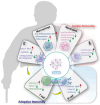Immune Alterations with Aging: Mechanisms and Intervention Strategies
- PMID: 39599617
- PMCID: PMC11597283
- DOI: 10.3390/nu16223830
Immune Alterations with Aging: Mechanisms and Intervention Strategies
Abstract
Aging is the result of a complex interplay of physical, environmental, and social factors, leading to an increased prevalence of chronic age-related diseases that burden health and social care systems. As the global population ages, it is crucial to understand the aged immune system, which undergoes declines in both innate and adaptive immunity. This immune decline exacerbates the aging process, creating a feedback loop that accelerates the onset of diseases, including infectious diseases, autoimmune disorders, and cancer. Intervention strategies, including dietary adjustments, pharmacological treatments, and immunomodulatory therapies, represent promising approaches to counteract immunosenescence. These interventions aim to enhance immune function by improving the activity and interactions of aging-affected immune cells, or by modulating inflammatory responses through the suppression of excessive cytokine secretion and inflammatory pathway activation. Such strategies have the potential to restore immune homeostasis and mitigate age-related inflammation, thus reducing the risk of chronic diseases linked to aging. In summary, this review provides insights into the effects and underlying mechanisms of immunosenescence, as well as its potential interventions, with particular emphasis on the relationship between aging, immunity, and nutritional factors.
Keywords: aging; diet intervention; immune system; immunosenescence; immunotherapy.
Conflict of interest statement
The authors declare no conflicts of interest.
Figures





References
Publication types
MeSH terms
Grants and funding
LinkOut - more resources
Full Text Sources
Medical
Research Materials

